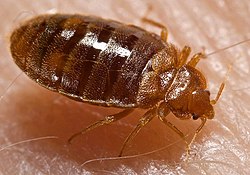Cimicidae
| Bed bug | |
|---|---|
 |
|
| Cimex lectularius | |
| Scientific classification | |
| Kingdom: | Animalia |
| Phylum: | Arthropoda |
| Class: | Insecta |
| Order: | Hemiptera |
| Superfamily: | Cimicoidea |
| Family: |
Cimicidae Latreille, 1802 |
| Subfamilies, Genera & Species | |
|
Subfamily Afrociminae Subfamily Cimicinae
Subfamily Cacodminae
Subfamily Haematosiphoninae
Subfamily Latrocimicinae
Subfamily Primicimicinae
|
|
Subfamily Afrociminae
Subfamily Cimicinae
Subfamily Cacodminae
Subfamily Haematosiphoninae
Subfamily Latrocimicinae
Subfamily Primicimicinae
The Cimicidae are a family of small parasitic insects that feed exclusively on the blood of warm-blooded animals. They are called cimicids or, loosely, bed bugs (or bedbugs or bed-bugs), though the latter term properly refers to the most famous species of the family, Cimex lectularius, the common bed bug. Around 90 species are placed in the family Cimicidae.
All cimicids are small, oval-shaped, and flat in appearance, although their bodies bulge after feeding. They do not fly, but do have small, nonfunctional wing pads. They also have beak-like mouth parts with which they pierce the skin and suck the blood of their hosts.
Cimicids practice traumatic insemination. Although the female has a normal genital tract for laying eggs, the male never uses it (except in the species Primicimex cavernis), instead piercing the female's abdominal wall; the sperm then migrate through the female's paragenital system.
Feeding is required for egg production in females and possibly for sperm production in males. Egg-laying behavior varies among species. C. lectularius stops laying fertile eggs about 35 to 50 days after the last insemination. The swallow bug, Oeciacus vicarius, hibernates after mating in autumn and begins laying in spring, to coincide with the return of the host.
The five nymphal instars (stages) must each take a blood meal to develop to the next stage. Adults have been reported to live 3-12 months in an untreated household situation. A given undisturbed bug may take 3-15 minutes to take a full meal depending on its life stage. They can survive long periods of time without feeding, reappearing from their hiding places when hosts again become available. They have special scent glands and often emit a characteristic odor that can usually be detected in heavily infested sites. Dark fecal spots on bedding or bedclothes, pearly white eggs (1 mm long), and papery yellowish cast “skins” are other signs of infestation often found in cracks or crevices.
Cimicidae are easily repelled by lavender, mint, and an excessive heat.
Cimicids are relatively specialized in their choice of hosts, compared to other bloodsucking insects. Most cimicids have a preferred host, but accept some others when presented with the choice, such as C. lectularius and C. hemipterus, which are most often found among humans, but can also survive by feeding on birds, bats, rabbits, and mice. Some subfamilies are restricted to certain types of bats, while one species, P. cavernis, appears to accept only one species of host.
...
Wikipedia
